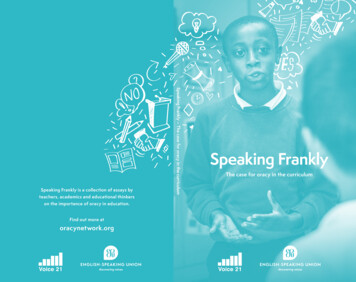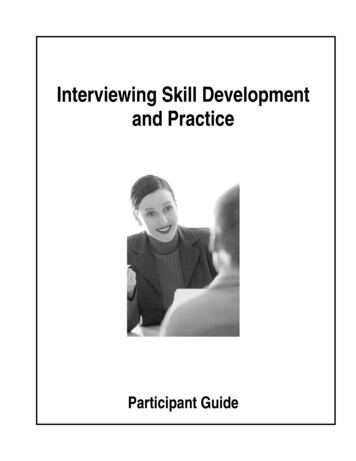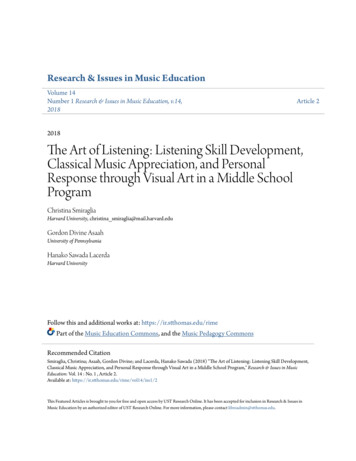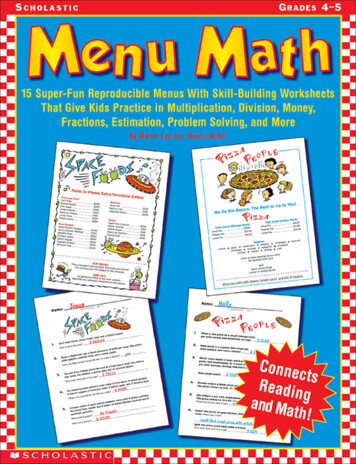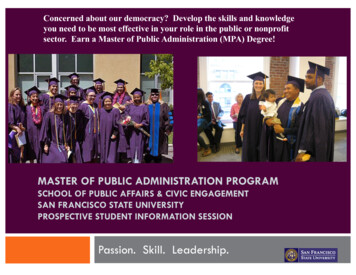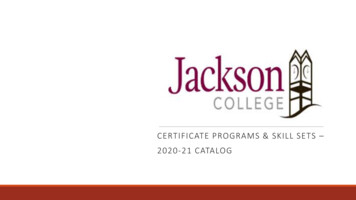
Transcription
TEACHING ANDIMPROVING SPEAKINGSKILLPHILADELPHIA UNIVERSITYTHE LANGUAGE CENTERDR.FAYZEH SHROUF
speakingWHAT IS SPEAKING?Speaking is "the process of building and sharing meaning through the use ofverbal and non-verbal symbols, in a variety of contexts" (Chaney, 1998, p. 13)Speaking is an interactive process of constructing meaning thatinvolves producing and receiving and processing information (Brown,1994; Burns & Joyce, 1997). Speaking is a crucial part of second languagelearning and teaching. Despite its importance, for many years, teachingspeaking has been undervalued and English language teachers havecontinued to teach speaking just as a repetition of drills or memorization ofdialogues. However, today's world requires that the goal of teaching speakingshould improve students' communicative skills, because, only in that way,students can express themselves and learn how to follow the social andcultural rules appropriate in each communicative circumstance,therfor,recentpedagogical research on teaching students conversation has provided someparameters for developing objectives and techniques.
Teaching SpeakingSpeaking English is the main goal of many adult learners. Theirpersonalities play a large role in determining how quickly and howcorrectly they will accomplish this goal. Those who are risk-takersunafraid of making mistakes will generally be more talkative, but withmany errors that could become hard to break habits. Conservative, shystudents may take a long time to speak confidently, but when they do, theirEnglish often contains fewer errors and they will be proud of their Englishability. It's a matter of quantity vs. quality, and neither approach is wrongso how shall we prioritize the two clearly important speaker goals ofaccurate(clear, articulate,grammatically and phonologicallycorrect)language and fluent(flowing,natural)language? However, if theaim of speaking is communication and that does not require perfectEnglish, then it makes sense to encourage quantity in your classroom.Break the silence and get students communicating with whatever Englishthey can use, correct or not, , and selectively address errors.
Speaking lessons often tie in pronunciation andgrammar which are necessary for effective oralcommunication. Or a grammar or reading lessonmay incorporate a speaking activity. Either way,your students will need some preparation before thespeaking task. This includes introducing the topicand providing a model of the speech they are toproduce. A model may not apply to discussion-typeactivities, in which case students will need clear andspecific instructions about the task to beaccomplished. Then the students will practice withthe actual speaking activity.
These activities may include imitating (repeating),answering verbal cues, interactive conversation, or anoral presentationHere are some ideas to keep in mind as you planyour speaking activities.
ContentAs much as possible, the content should be practicaland usable in real-life situations. Avoid too much newvocabulary or grammar, and focus on speaking withthe language the students have.
Correcting ErrorsYou need to provide appropriate feedback andcorrection, but don't interrupt the flow ofcommunication. Take notes while pairs or groups aretalking and address problems to the class after theactivity without embarrassing the student who madethe error. You can write the error on the board andask who can correct it.
Quantity vs. QualityAddress both interactive fluency and accuracy,striving foremost for communication. Get to knoweach learner's personality and encourage the quieterones to take more risks
Conversation StrategiesEncourage strategies like asking for clarification,paraphrasing, gestures, and initiating ('hey,' 'so,' 'bythe way').
Teacher InterventionIf a speaking activity loses steam, you may need tojump into a role-play, ask more discussion questions,clarify your instructions, or stop an activity that istoo difficult or boring.
How To Teach SpeakingNow many linguistics and ESL teachers agree on thatstudents learn to speak in the second language by"interacting". Communicative language teaching andcollaborative learning serve best for this aim.Communicative language teaching is based on real-lifesituations that require communication. By using thismethod in ESL classes, students will have theopportunity of communicating with each other in thetarget language. In brief, ESL teachers should create aclassroom environment where students have real-lifecommunication, authentic activities, and meaningfultasks that promote oral language. This can occur whenstudents collaborate in groups to achieve a goal or tocomplete a task.
Activities To Promote Speaking Discussion Role Play Simulation Information Gap Brainstorming Storytelling Interviews Story Completion Picture Narrating Picture Describing Find the Difference
DiscussionsAfter a content-based lesson, a discussion can be held for various reasons.The students may aim to arrive at a conclusion, share ideas about anevent, or find solutions in their discussion groups. Before the discussion,it is essential that the purpose of the discussion activity is set by theteacher. In this way, the discussion points are relevant to this purpose, sothat students do not spend their time chatting with each other aboutirrelevant things. For example, students can become involved inagree/disagree discussions. In this type of discussions, the teacher canform groups of students, preferably 4 or 5 in each group, and providecontroversial sentences like “people learn best when they read vs. peoplelearn best when they travel”. Then each group works on their topic for agiven time period, and presents their opinions to the class. It is essentialthat the speaking should be equally divided among group members. Atthe end, the class decides on the winning group who defended the idea inthe best way. This activity fosters critical thinking and quick decisionmaking, and students learn how to express and justify themselves inpolite ways while disagreeing with the others. For efficient groupdiscussions, it is always better not to form large groups, because quietstudents may avoid contributing in large groups. The group members canbe either assigned by the teacher or the students may determine it bythemselves, but groups should be rearranged in every discussion activityso that students can work with various people and learn to be open todifferent ideas.
Teachers can come out with interesting,authentic and essential topics that students candiscuss or talk about especially in the targetlanguage. The related topics should be easy andunderstandable. As a start ESL teachers canrelate the topics with students' interests beforemoving to serious topics like national issues orthe world politics. Lastly , in class or groupdiscussions, whatever the aim is, the studentsshould always be encouraged to ask questions,paraphrase ideas, express support, check forclarification, and so on.
Role PlayOne other way of getting students to speak is roleplaying. Students pretend they are in various socialcontexts and have a variety of social roles. In roleplay activities, the teacher gives information to thelearners such as who they are and what they think orfeel. Thus, the teacher can tell the student that "Youare Ali, you go to the doctor and tell him whathappened last night, and what they think or feel.
SimulationsSimulations are very similar to role-plays but whatmakes simulations different than role plays is that theyare more elaborate. In simulations, students can bringitems to the class to create a realistic environment. Forinstance, if a student is acting as a singer, she or hebrings a microphone to sing and so on. Role plays andsimulations have many advantages. First, since they areentertaining, they motivate the students. Second, asHarmer (1984) suggests, they increase the selfconfidence of hesitant students, because in role play andsimulation activities, they will have a different role anddo not have to speak for themselves, which means theydo not have to take the same responsibility.
Information GapIn this activity, students are supposed to be working inpairs. One student will have the information that otherpartner does not have and the partners will share theirinformation. Information gap activities serve manypurposes such as solving a problem or collectinginformation. Also, each partner plays an important rolebecause the task cannot be completed if the partners donot provide the information the others need. Theseactivities are effective because everybody has theopportunity to talk extensively in the target language.
Information-gap activitiesA’sInformationPerson’s nameFromSarah (female)OccupationDoctorProfessorKhaled (male)MoviesRomanceGo fishingAmmanAqabaAmal (female)WeekendsActionBankerPlay cardsOccupationWeekendsIrbedB’s InformationPerson’s nameFromJerashAli (male)MoviesRelax at homeKerakH0rrorMechanicPlay footballLeen (female)DramaLawyerRead novelsComedy
The objective is for students to ask questions to find out what they canfrom the other(s). Sample Questions:What is the first person's name?How do you spell it?Where is he/she from?What is his/her occupationWhat does he/she do on weekends?What kind of movies does he/she like? After completing the chart,students discuss withtheir partners: Which person would each like as afriend? Why?
BrainstormingOn a given topic, students can produce ideas in alimited time. Depending on the context, eitherindividual or group brainstorming is effective andlearners generate ideas quickly and freely. The goodcharacteristics of brainstorming is that the studentsare not criticized for their ideas so students will beopen to sharing new ideas.
StorytellingStudents can briefly summarize a tale or story they heardfrom somebody beforehand, or they may create their ownstories to tell their classmates. Story telling fosterscreative thinking. It also helps students express ideas inthe format of beginning, development, and ending,including the characters and setting a story has to have.Students also can tell riddles or jokes. For instance, at thevery beginning of each class session, the teacher may calla few students to tell short riddles or jokes as an opening.
InterviewsStudents can conduct interviews on selected topicswith various people. It is a good idea that the teacherprovides a rubric to students so that they know whattype of questions they can ask or what path to follow,but students should prepare their own interviewquestions. Conducting interviews with people givesstudents a chance to practice their speaking abilitynot only in class but also outside and helps thembecoming socialized. After interviews, each studentcan present his or her study to the class. Moreover,students can interview each other and "introduce"his or her partner to the class.
Story CompletionBefore coming to class, students are asked to read anewspaper or magazine and, in class, they report totheir friends what they find as the most interestingnews. Students can also talk about whether they haveexperienced anything worth telling their friends intheir daily lives before class.
Picture NarratingThis activity is based on several sequential pictures.Students are asked to tell the story taking place inthe sequential pictures by paying attention to thecriteria provided by the teacher as a rubric. Rubricscan include the vocabulary or structures they need touse while narrating.
Picture DescribingAnother way to make use of pictures in a speakingactivity is to give students just one picture and havingthem describe what it is in the picture. For this activitystudents can form groups and each group is given adifferent picture. Students discuss the picture with theirgroups, then a spokesperson for each group describes thepicture to the whole class. This activity fosters thecreativity and imagination of the learners as well as theirpublic speaking skills.
Find the DifferenceFor this activity students can work in pairs and eachcouple is given two different pictures, for example,picture of boys playing football and another pictureof girls playing tennis. Students in pairs discuss thesimilarities and/or differences in the pictures.
ConclusionSpeaking is the key to communication. Byconsidering what good speakers do, what speakingtasks can be used in class, and what specific needslearners report, teachers can help learners toimprove their speaking and overall oralcompetency.
Teaching speaking is a very important part of secondlanguage learning. The ability to communicate in asecond language clearly and efficiently contributes tothe success of the learner in school and success later inevery phase of life. Therefore, it is essential thatlanguage teachers pay great attention to teachingspeaking. Rather than leading students to purememorization, providing a rich environment wheremeaningful communication takes place is desired. Withthis aim, various speaking activities such as those listedbefore can contribute a great deal to students indeveloping basic interactive skills necessary for life.These activities make students more active in thelearning process and at the same time make theirlearning more meaningful and fun for them.
Thank you!Dr. Fayzeh Shrouf
Speaking is an interactive process of constructing meaning that involves producing and receiving and processing information (Brown, 1994; Burns & Joyce, 1997). Speaking is a crucial part of second language learning and teaching. Despite its importance, for many years, teaching speaking has been underv
